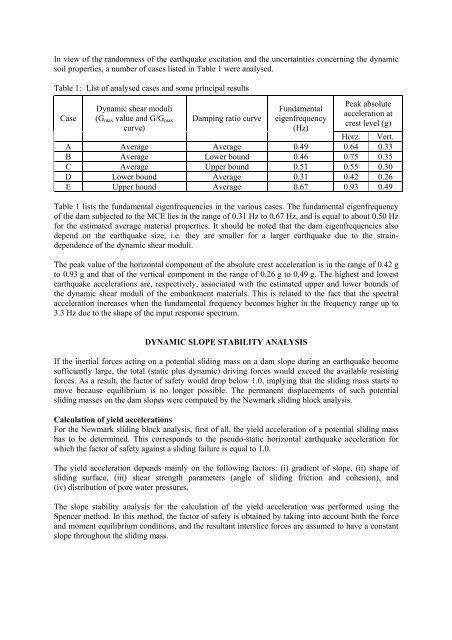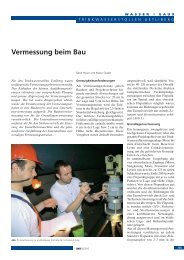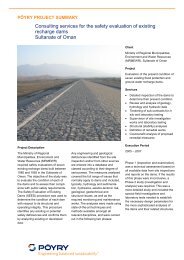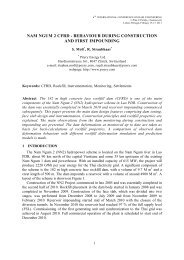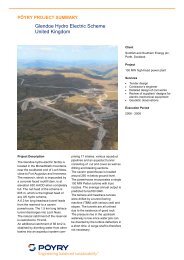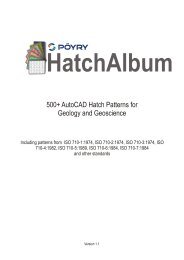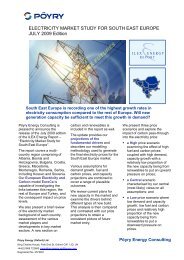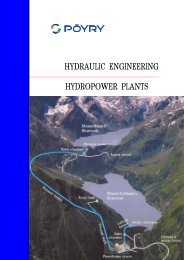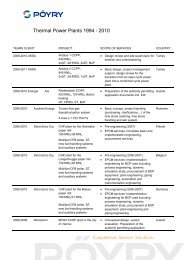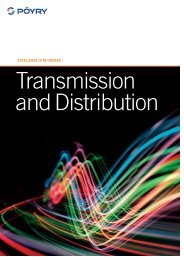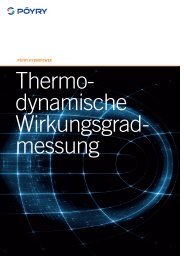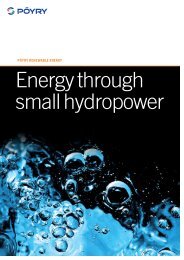EARTHQUAKE SAFETY EVALUATION OF ATATURK DAM
EARTHQUAKE SAFETY EVALUATION OF ATATURK DAM
EARTHQUAKE SAFETY EVALUATION OF ATATURK DAM
Create successful ePaper yourself
Turn your PDF publications into a flip-book with our unique Google optimized e-Paper software.
In view of the randomness of the earthquake excitation and the uncertainties concerning the dynamic<br />
soil properties, a number of cases listed in Table 1 were analysed.<br />
Table 1: List of analysed cases and some principal results<br />
Case<br />
Dynamic shear moduli<br />
(Gmax value and G/Gmax<br />
curve)<br />
Damping ratio curve<br />
Fundamental<br />
eigenfrequency<br />
(Hz)<br />
Peak absolute<br />
acceleration at<br />
crest level (g)<br />
Horz. Vert.<br />
A Average Average 0.49 0.64 0.33<br />
B Average Lower bound 0.46 0.75 0.35<br />
C Average Upper bound 0.51 0.55 0.30<br />
D Lower bound Average 0.31 0.42 0.26<br />
E Upper bound Average 0.67 0.93 0.49<br />
Table 1 lists the fundamental eigenfrequencies in the various cases. The fundamental eigenfrequency<br />
of the dam subjected to the MCE lies in the range of 0.31 Hz to 0.67 Hz, and is equal to about 0.50 Hz<br />
for the estimated average material properties. It should be noted that the dam eigenfrequencies also<br />
depend on the earthquake size, i.e. they are smaller for a larger earthquake due to the straindependence<br />
of the dynamic shear moduli.<br />
The peak value of the horizontal component of the absolute crest acceleration is in the range of 0.42 g<br />
to 0.93 g and that of the vertical component in the range of 0.26 g to 0.49 g. The highest and lowest<br />
earthquake accelerations are, respectively, associated with the estimated upper and lower bounds of<br />
the dynamic shear moduli of the embankment materials. This is related to the fact that the spectral<br />
acceleration increases when the fundamental frequency becomes higher in the frequency range up to<br />
3.3 Hz due to the shape of the input response spectrum.<br />
DYNAMIC SLOPE STABILITY ANALYSIS<br />
If the inertial forces acting on a potential sliding mass on a dam slope during an earthquake become<br />
sufficiently large, the total (static plus dynamic) driving forces would exceed the available resisting<br />
forces. As a result, the factor of safety would drop below 1.0, implying that the sliding mass starts to<br />
move because equilibrium is no longer possible. The permanent displacements of such potential<br />
sliding masses on the dam slopes were computed by the Newmark sliding block analysis.<br />
Calculation of yield accelerations<br />
For the Newmark sliding block analysis, first of all, the yield acceleration of a potential sliding mass<br />
has to be determined. This corresponds to the pseudo-static horizontal earthquake acceleration for<br />
which the factor of safety against a sliding failure is equal to 1.0.<br />
The yield acceleration depends mainly on the following factors: (i) gradient of slope, (ii) shape of<br />
sliding surface, (iii) shear strength parameters (angle of sliding friction and cohesion), and<br />
(iv) distribution of pore water pressures.<br />
The slope stability analysis for the calculation of the yield acceleration was performed using the<br />
Spencer method. In this method, the factor of safety is obtained by taking into account both the force<br />
and moment equilibrium conditions, and the resultant interslice forces are assumed to have a constant<br />
slope throughout the sliding mass.


